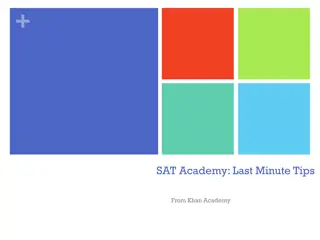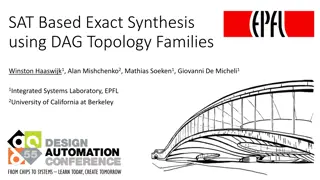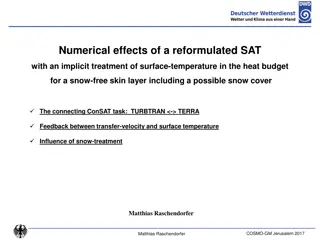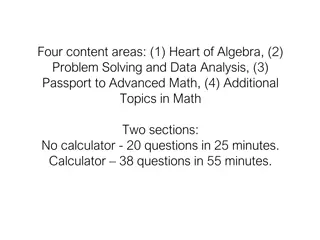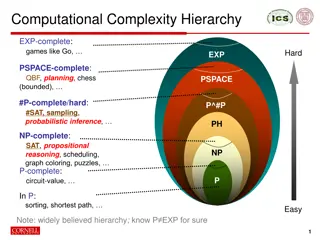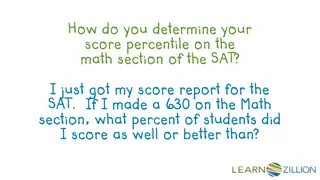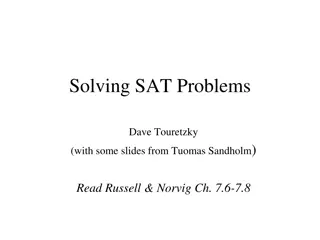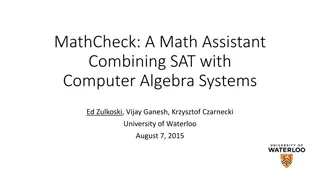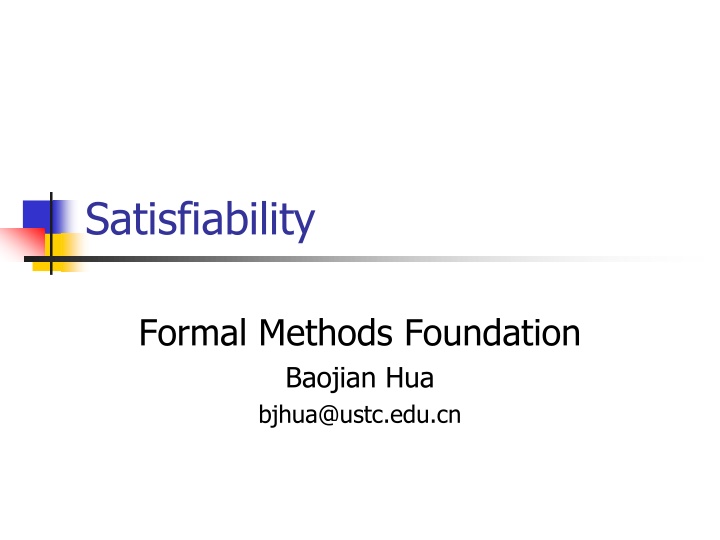
Satisfiability Problem in Formal Methods
Explore the significance of the Satisfiability (SAT) problem in mathematics and computer science, its relation to boolean satisfiability, algorithms like brute force SAT, and the advancements in solving SAT problems efficiently. Get insights into the complexity of SAT, its NP-Completeness, practical algorithms, and the roadmap to study the DPLL algorithm.
Uploaded on | 1 Views
Download Presentation

Please find below an Image/Link to download the presentation.
The content on the website is provided AS IS for your information and personal use only. It may not be sold, licensed, or shared on other websites without obtaining consent from the author. If you encounter any issues during the download, it is possible that the publisher has removed the file from their server.
You are allowed to download the files provided on this website for personal or commercial use, subject to the condition that they are used lawfully. All files are the property of their respective owners.
The content on the website is provided AS IS for your information and personal use only. It may not be sold, licensed, or shared on other websites without obtaining consent from the author.
E N D
Presentation Transcript
Satisfiability Formal Methods Foundation Baojian Hua bjhua@ustc.edu.cn
Satisfiability (SAT) Satisfiability is a key problem in math To answer whether or not a proposition can evaluate to true, under some model One of the fundamental problems in CS Many theoretical studies The 1stNPC (Cook-Levin, 1971) Many algorithmic improvements to make it practical enough Many applications We ll discuss some in future lectures
Motivation Recall the truth table: ?\/? T T T F P T T F F Q T F T F SAT: for a given proposition P, is there a model that makes P true? Also called a boolean satisfiability problem
Motivation Recall the truth table: ?\/? T T T F P T T F F Q T F T F P/\~P F F F F SAT: for a given proposition P, is there a model that makes P true?
SAT vs. valid So, sat is weaker than valid Valid: in all model, P is true Sat: in one model, P is true But there is an important relationship: Valid(P) <==> unsat(~P) So, in order to prove P, we can show unsatisfiability of ~P
?\/? T T T F P T T F F Q T F T F SAT algorithm bool bruteForceSat(P){ for(each row of the truth table for P) if(eval(P) == T) return true; return false; } // Remarks: // 1. This is a brute force algorithm! // 2. SAT is decidable! // 3. The complexity is O(??), where n is // the number of atomic vars in P. Exponential.
SAT is NP-Complete Can we do better than the above exponential algorithm? Short answer: unknown P=NP? SAT is the 1stNPC (Cook-Levin, 1971) But there are many algorithmic breakthroughs in recent years Make many practical SAT problems solvable
Progress 100000 10000 1000 Vars 100 10 1 1960 1970 1980 1990 2000 2010 Year
Roadmap We ll study a very popular algorithm: DPLL The roadmap: Normal form: Key insights: don t handle arbitrary propositions, but only normalized ones the simpler, the easier Negation normal (NNF), conjunctive normal form (CNF) Resolution Key insight: simplify propositions during eval
Negation normal form P ::= p Right is the CFG for NNF: Negation only appears before atomic vars No implication -> NNF example: p1 /\ ~p2 \/ p3 \/ ~p4 Non NNF: p1 /\ ~(p2 \/ p3) \/ ~p4 | p | T | | P P | P P
Implication elimination Rules for eliminating implication: C(p) = p C(~p) = ~p C(P/\Q) = C(P) /\ C(Q) C(P\/Q) = C(P) \/ C(Q) C(P->Q) = ~C(P) \/ C(Q)
Implication elimination example C(p -> (q -> p)) = ~C(p) \/ C(q -> p) = ~p \/ (~C(q) \/ C(p)) = ~p \/ (~q \/ p) And the final result can be further turned into: = ~p \/ p \/ ~q = T
Conversion into NNF Rules for conversion into NNF: C(p) = p C(~p) = ~p C(~~P) = C(P) C(P/\Q) = C(P) /\ C(Q) C(P\/Q) = C(P) \/ C(Q) C(~(P/\Q)) = C(~P) \/ C(~Q) C(~(P\/Q)) = C(~P) /\ C(~Q)
NNF conversion example C(~((p1 /\ ~p2) \/ (p3 \/ ~p4))) = C(~(p1 /\ ~p2)) /\ C(~(p3 \/ ~p4)) = (C(~p1) \/ C(~(~p2))) /\ (C(~p3) \/ C(~(~p4))) = (~p1 \/ p2) \/ (~p3 \/ p4) So intuitively, NNF basically pushes the ~ connective deeper into a given proposition.
Conjunctive normal form(CNF) P::= D /\ P D ::= D \/ A A ::= p | p | T | The CFG for CNF right A proposition P is a conjunction of disjunctive clause D D is a disjunction of atoms CNF Example: (p1 \/ ~p2) /\ (p3 \/ ~p4) Non CNF: p1 /\ (~p2 \/ p3) \/ ~p4
Conversion into CNF Rules for converting into CNF: C(p) = p C(~p) = ~p C(P/\Q) = C(P) /\ C(Q) C(P\/Q) = D(C(P), C(Q)) D(P=P1/\P2, Q) = D(P1, Q) /\ D(P2, Q) D(P, Q=Q1/\Q2) = D(P, Q1) /\ D(P, Q2) D(P, Q) = P \/ Q
CNF example C((~p1 /\ p2) \/ (~p2 /\ p4)) = D(C(~p1 /\ p2), C(~p2 /\ p4)) = D(~p1 /\ p2, ~p2 /\ p4) = D(~p1, ~p2 /\ p4) /\ D(p2, ~p2 /\ p4) = (D(~p1, ~p2) /\ D(~p1, p4)) /\ = ((~p1\/~p2) /\ (~p1\/p4)) /\ Remarks: Think both C( ) and D( ) as compilers; The D( ) function basically pushes the \/ connective deeper into a given proposition P. 1. 2.
DIMACS standard For CNF, each prop is denoted by a positive integer, it s negation is the corresponding negative number, each clause is ended by 0 Example: (~p1\/~p2) /\ (~p1\/p4) -1 -2 0 -1 4 0
DPLL algorithm An initial but still very popular algorithm Davis-Putnam (DP) algorithm, 1960 Davis, Logemann, and Loveland, 1962 Based on the truth table method, but with key improvements: Splitting rule Unit propagation (1-clause) rule
DPLL motivation To check the satisfiability of: (~p1\/~p2) /\ (p2\/p4) 1. Splitting: (~p1\/~p2) /\ (p2\/p4) p1 = F p1 = T (~T\/~p2) /\ (p2\/p4) (~F\/~p2) /\ (p2\/p4)
DPLL motivation To check the satisfiability of: (~p1\/~p2) /\ (p2\/p4) 1. Splitting: (~p1\/~p2) /\ (p2\/p4) p1 = F p1 = T ~p2 /\ (p2\/p4) p2\/p4 p2 should only be F, in order to make the whole prop. SAT
DPLL motivation To check the satisfiability of: (~p1\/~p2) /\ (p2\/p4) 1. Splitting: (~p1\/~p2) /\ (p2\/p4) p1 = F p1 = T p2 = F ~F /\ (p2\/p4) p2\/p4 And propagate the the value of p2 into other clause
DPLL motivation To check the satisfiability of: (~p1\/~p2) /\ (p2\/p4) 1. Splitting: (~p1\/~p2) /\ (p2\/p4) p1 = F p1 = T p2 = F ~F /\ (F \/p4) p2\/p4 And propagate the the value of p2 into other clause
DPLL motivation To check the satisfiability of: (~p1\/~p2) /\ (p2\/p4) 1. Splitting: (~p1\/~p2) /\ (p2\/p4) p1 = F p1 = T p2 = F p4 p2\/p4 Local simplification
DPLL motivation To check the satisfiability of: (~p1\/~p2) /\ (p2\/p4) 1. Splitting: (~p1\/~p2) /\ (p2\/p4) p4 = T p1 = F p1 = T p2 = F p4 p2\/p4 Trivial assignment to p4
DPLL motivation To check the satisfiability of: (~p1\/~p2) /\ (p2\/p4) 1. Splitting: (~p1\/~p2) /\ (p2\/p4) p4 = T p1 = F p1 = T p2 = F T p2\/p4 The model: [p1=T, p2=F, p4=T] We only need just 1 try, instead of 23= 8 !
DPLL algorithm dpll(P){ if(P==T) return sat; if(P==F) return unsat; unitProp(P); // unit prop and simplify P x = select_atomic(P); // choose an atomic prop if(dpll(P[x|->T])) // splitting return sat; return dpll(P[x|->F]); }
State-of-the-art New algorithms: E.g., CDCL Many improvements and engineering effort Careful encoding of the propositions Backtracking As a result, modern SAT solvers are practical enough
The general scheme The hard part! Solution found! Problem modeling/ constraints SAT SAT solver/ Theorem prover UNSAT No solutions Memout/ timeout UNKNOWN
Example 1: circuit layout SAT for the following prop: ((A /\ B) /\ D) \/ ((A /\ B) /\ ~C) Output True ?
Example 2: seat arrangement Modeling the problem: 1. Ai: Alice takes seat Ai 2. Bi: Bob takes seat Bi 3. Ci: Bob take the seat Ci Where 1<=i<=3. 3 people Alice, Bob, Carol, take 3 seats. Constraints: 1. Alice cannot sit near to Carol; 2. Bob cannot sit right to Alice. Modeling the constraint: 1. Alice must take just one seat: (A1/\~A2/\~A3) \/ (~A1/\A2/\~A3) \/ (~A1/\~A2/\A3) 2. Bob (Carol) takes just one seat: 3. The 1stseat just taken by 1 person: (A1/\~B1/\~C1) \/ (~A1/\B1/\~C1) \/ (~A1/\~B1/\C1) 4. Alice cannot sit near to Carol: (A1->~B2)/\(A2->~B1)/\(A2->~B3)/\(A3- >~B2) Question: 1. Is there any solution? 2. How many solutions in total?
Example 3: subset sum Given an integer set S, is there a subset T S and T , such that T = 0. Modeling the problem: 1. x_i: a proposition indicating whether the ith element in S is selected. E.g., x_0 x_1 x_2 x_3 {2, 3, 8, -5} Example: {2, 3, 8, -5} the subset: {2, 3, -5}. Then we have: (x_i S[i]) \/ ( x_i 0) Or abbreviated as an if expression: If(x_i, S[i], 0) The following encodes T = 0: If(x_0, S[0], 0) + + If(x_n, S[n], 0) == 0 And the subset is nonempty T : Or(x_0, , x_n)
Example 4: knapsack We model the existence part (i.e., without the target function) of knapsack with SAT: 1. x_i: whether to select the ith item. We have the constraint: (If(x_i), W[i], 0) <= C Problem: given n items with weight W[] and value V[]: t1 V v1 W w1 tn vn wn For a knapsack of maximal weight C, how to select some items to maximize V[].
Example 5: n-queens puzzle Modeling the problem: bool board[n][n]: board[i][j]={true, if there is a queen; {false, This is equivalent to: If(board[i][j], 1, 0) write as e[i][j] otherwise. Is it possible to put n queens on a n*n board, so that no queens can attack each other? 1. Not on the same row; 2. Not on the same column; 3. Not on the same diagonal. Generate the constraints: 1. Every row has exactly 1 queen: (e[0][0], e[0][1], e[0][2], e[0][3])=1 (e[1][0], e[1][1], e[1][2], e[1][3])=1 (e[2][0], e[2][1], e[2][2], e[2][3])=1 (e[3][0], e[3][1], e[3][2], e[3][3])=1 2. Each column has exactly 1 queen: // leave as exercise 3. Each diagonal has at most one queen: // leave as exercise E.g., the above is a solution to the 4-queens puzzle.
Example 5: n-queens puzzle The problem is inherently exponential O(2?2) The formulae for n-queens is still unknown But easier to solve with SAT
Summary SAT-based problem solving has a natural deductive flavor Thus make the problem easier to express You can compare with more traditional recursion-based or loop-based method But encoding problems into SAT may be tedious and error-prone We ll discuss more advanced techniques, in future lectures


